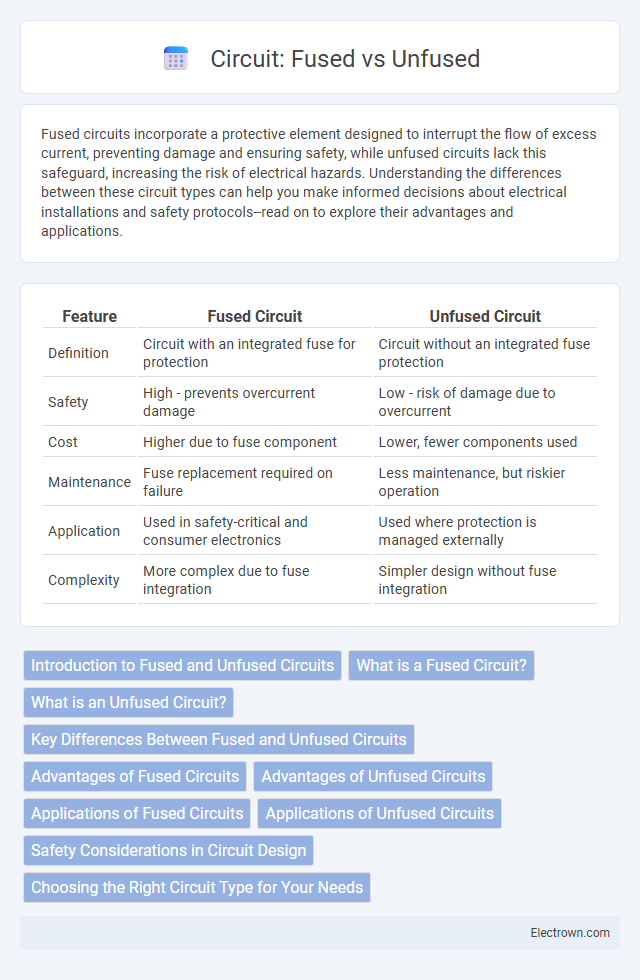Fused circuits incorporate a protective element designed to interrupt the flow of excess current, preventing damage and ensuring safety, while unfused circuits lack this safeguard, increasing the risk of electrical hazards. Understanding the differences between these circuit types can help you make informed decisions about electrical installations and safety protocols--read on to explore their advantages and applications.
Table of Comparison
| Feature | Fused Circuit | Unfused Circuit |
|---|---|---|
| Definition | Circuit with an integrated fuse for protection | Circuit without an integrated fuse protection |
| Safety | High - prevents overcurrent damage | Low - risk of damage due to overcurrent |
| Cost | Higher due to fuse component | Lower, fewer components used |
| Maintenance | Fuse replacement required on failure | Less maintenance, but riskier operation |
| Application | Used in safety-critical and consumer electronics | Used where protection is managed externally |
| Complexity | More complex due to fuse integration | Simpler design without fuse integration |
Introduction to Fused and Unfused Circuits
Fused circuits include a fuse component that protects electrical systems by breaking the circuit during overcurrent conditions, preventing damage or fire hazards. Unfused circuits lack this protective device, making them more vulnerable to overloads and short circuits. Understanding the difference between fused and unfused circuits is essential for ensuring the safety and reliability of Your electrical installations.
What is a Fused Circuit?
A fused circuit includes a fuse device designed to protect electrical wiring by breaking the circuit if current flow exceeds safe levels, preventing damage or fire hazards. This safety component is essential for maintaining system integrity and ensuring reliable operation. Your electrical setup benefits from enhanced protection through the timely interruption of excessive current by a fused circuit.
What is an Unfused Circuit?
An unfused circuit lacks a protective fuse, which means it does not have a component designed to interrupt the electrical flow during overloads or short circuits. This absence increases the risk of damage to your electrical devices and potential fire hazards due to unchecked current flow. Understanding the risks associated with an unfused circuit helps ensure you prioritize safety and proper circuit protection.
Key Differences Between Fused and Unfused Circuits
Fused circuits incorporate a fuse that protects your electrical system by interrupting current flow during overloads or short circuits, preventing damage and fire hazards. Unfused circuits lack this protective component, making them more vulnerable to electrical faults that can lead to equipment failure or safety risks. Understanding these differences helps in selecting the appropriate circuit design for safety and reliability.
Advantages of Fused Circuits
Fused circuits provide essential protection by preventing overcurrent conditions that can damage electrical components or cause fires. They enhance safety by interrupting the power supply during fault conditions, reducing the risk of electrical hazards. Your electrical system benefits from increased reliability and prolonged lifespan of devices when fused circuits are installed.
Advantages of Unfused Circuits
Unfused circuits offer enhanced safety by allowing individual components to reset automatically when voltage or current overloads occur, preventing permanent damage. They provide cost-effective protection in low-risk applications by eliminating the need for fused elements, reducing maintenance and replacement expenses. Your system benefits from greater operational continuity, as unfused circuits minimize downtime caused by fuse replacements.
Applications of Fused Circuits
Fused circuits are essential in protecting electrical devices by interrupting excessive current and preventing damage in residential, automotive, and industrial applications. Your electronic systems benefit from enhanced safety and reliability when fused circuits are used in power distribution panels, consumer electronics, and motor protection. Their ability to isolate faults quickly minimizes the risk of fire hazards and equipment failure in critical infrastructure.
Applications of Unfused Circuits
Unfused circuits are primarily used in applications where the load is naturally current-limiting or in low-power electronic devices such as control circuits and signal processing units. These circuits rely on inherent resistance and circuit design to prevent damage from short circuits or overloads, making them suitable for sensitive or precise electronic components. Your choice of an unfused circuit is ideal in environments where quick response and minimized interruptions are critical without the need for additional protective elements like fuses.
Safety Considerations in Circuit Design
Fused circuits incorporate protective elements like fuses to interrupt excessive current flow, preventing overheating and potential fire hazards, which significantly enhances circuit safety. Unfused circuits lack this immediate protective measure, increasing the risk of component damage and safety hazards in case of faults or short circuits. Designers prioritize fused circuits in safety-critical applications to ensure reliable fault isolation and minimize danger to users and equipment.
Choosing the Right Circuit Type for Your Needs
Choosing the right circuit type depends on your specific application and safety requirements. Fused circuits provide protection by interrupting current flow during faults, ideal for preventing equipment damage. Unfused circuits offer simplicity and cost savings but lack overload protection, making them suitable only where circuit protection is managed separately.
Fused vs Unfused Circuit Infographic

 electrown.com
electrown.com